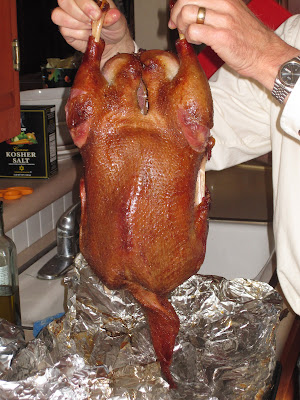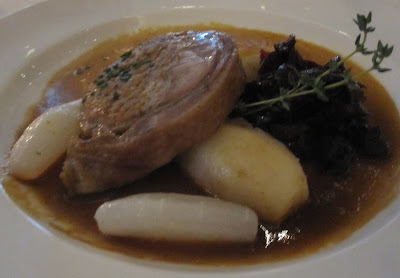GOOSE: One of my friends knew the owner of Lotus Gardens in San Bernardino and asked them to roast a goose that he provided to them (they normally don't sell goose) for a group of four of us.
Later, we had our firm Christmas party at Lotus Garden and I arranged with them to cook and serve a goose Peking style (like Peking duck). They found an 11+ pound goose in Los Angeles specifically for our party. The goose is not as flavorful or tender as duck, but the presentation was amazing.
Judy ordered a smoked goose from North Carolina as part of one of our Thanksgiving dinners. We wrapped it in foil and put it on the grill for 40 minutes. The meat was reddish and smoky smelling and tasted much like smoked ham or bacon.
We ate at Hung's Delicacies in the Hong Kong Airport, named the world's best airport restaurant by CNN. We had Lou Seoi goose which is braised with a combination of herbs and soy sauce which gives a golden-glazed appearance, unlike the Cantonese crispy-skinned roast goose. Nice and moist. We also had a combination plate which included Lou Seoi goose kidney which was rigid, chewy and had little taste.
 |
| Goose kidney is at the front of the plate. |
On the Emerald Princess in the Baltic Sea we had roast goose with radishes and potatoes which was quite good.
We've had goose mousse which had goose and duck liver, and duck and chicken fat. It was mild, had no liver taste, was slightly sweet and the texture of smooth butter.
My brother-in-law, Stan Jones, in Montana, has a friend that shoots wild Canada geese and makes jerky with the meat. He sent me some and it was great.
GROUPER: We don't get grouper, a kind of fish, on the west coast. I've eaten it a number of times elsewhere and really like it. I had breaded and fried grouper at the Coconut Grove Beach Resort outside of Elmina, Ghana.
GROUSE: I got a wild shot red grouse from Scotland from Exotic Meat Market ("EMM"). It was very dark meat and I read that it was gamy. So I brined it about 20 hours, which removed a lot of blood, then let it cool in the refrigerator for 24 hours, then cut it in half and cooked it sous vide. I put half in a salad and ate the other half by itself. It was too salty, so I felt like I brined it too long.
GUINEA FOWL: I ordered pintada, the French word for Guinea fowl at Au Cinquieme Peche in Montreal. It was beautifully presented with red and yellow beets, lobster mushrooms and pureed squash. The flesh was moist and flavorful and the skin was even better.
 |
| A Guinea fowl in Kenya. |
I purchased a Guinea fowl raised in California (it may have been through EMM) and cooked it in an infrared cooker, covered in bacon. It is much better than pheasant and much like chicken.
GUINEA PIG: At the restaurant Incanto in Cusco, Peru I had roasted Guinea pig cooked in a huge oven. There were two versions on the menu, one that seemed to include legs and thighs and one that had legs, thighs and ribs. It was very good.
I got four Guinea pigs from EMM, smaller than the version in Peru. The first two I coated in flour and cooked them in a frying pan. No gaminess and they were moist and flavorful. The other two I cooked sous vide and did not like them as well.
HARE: I got a mountain hare, also known as a blue hare and tundra hare. It is brown in the summer and white in the winter and is very similar to our American jackrabbit with long ears and large hindquarters. I got it from EMM who got it from Scotland. It was a dark purplish meat and very lean. Without much preparation I baked it and it was like beef jerkey, one of my culinary disaster. So I ordered another one from EMM, determined to do it better. The second time I brined it for 2 1/2 days. Then I coated it in flower and fried it until brown. I cooked vegetables and added flour to make a roux, then added the hare and simmered it for three hours. The final result was fantastic, the meat fell off the bones and the vegetable slush was great. This was one of my better cooking jobs.
 |
| The second hare. The photos are in backwards order. |
HERRING: We visited Barney Greengrass: The Sturgeon King in New York City, part deli. We purchased some schmaltz herring which is herring caught just before spawning when the fat (schmaltz in Yiddish) content is highest. We bought two small strips. It is very soft, almost like moldy on the outside (although it wasn't) and has a powerful taste, almost like anchovies. The combination of texture and taste made it difficult to eat. Judy took one bite, I took four. The rest went into the trash.
I've had smoked herring in the Isle of Man several times and it is marvelous. So I saw some smaller smoked herrings in a Chinese market and served them to my sister's family along with some eel and other fun food. It was pure misery to chew and then swallow. It was dry, had a freeze-dried consistency and a bitter taste that got worse the more I chewed it.
HORSE: Our first taste of horse was at an amazing dinner. We were in Tokyo and our daughter, who lived there, arranged for us to go to a restaurant that served only horse (she knew that I wanted to try horse meat) and all of the servers spoke only Japanese. The staff brought an English speaking waiter from a restaurant downstairs to go over the menu with us (which was in Japanese) and we selected the all-horse dinner. The first course was a bowl of soup with chunks of horse meat in it. I was surprised that horse meat was kind of sweet. I don't have a photo of it. Our second course was raw horse (sashimi) called basashi by the Japanese. There were three types, each from a different part of the horse. The white was was from the neck, and extremely fatty and very soft. One was dark red without much visible fat and the third was less red and marbled with streaks of fat. There were three or four pieces of each kind for each of us. The photo was taken after we ate most of it.
For the third course a waitress brought in a plate of horse sashimi and mushrooms and bell pepper and put them on the grill (called a yakiniku). The cooked meat is called baniku (horse meat) or bagushi (skewered horse). It was tender, slightly sweet and delicious.
The fourth course was horse tartare with a raw quail egg. It was ground raw horse called sakuraniku (which means pink colored meat). It also had seaweed, chopped onions and a sauce. We mixed it together and ate it. It was my first time eating tartare and raw egg and I was a little squeamish.
The fifth course of horse was a soup with a thick yellow custard type of ingredient with chunks of horse meat. It was creamy and delicious.
Our last course was maple ice cream with some kiwi slices.
In Urumqi, China, in the northwestern Xinjiang Region, I'd read that there were lots of Kazakh people there that liked to eat horse. We had a brief train stop there, so I had our guide take us to a store that had horse. It was in a package in Chinese with a horse on the front. It was a pinkish-red and fatty and tasted like corned beef, but sweeter.
Later on the same trip we visited Almaty, Kazakhstan and visited Abay Restaurant. We had shuzhuk, a horse sausage, as an appetizer. It was very good.
As a main course we had besbarmak, a traditional Kazakh dish, which includes a piece of horse rump, kazy, a horse meat sausage from horse rib meat and shuzhuk, above, which is horse meat sausage with more fat in it.
 |
| You can see the shuzuk in the Besbarmak, most clearly at bottom right. |
 |
| Boiled horse flank in the Besbarmak. |
 |
| Kazy, horse sausage, in the Besbarmak. |
At Tapas Barinn in Reykjavik, Iceland, we had filet of Icelandic foal (young horse) with truffle mashed potatoes. It was not as sweet and tender as some of our prior horse, but was still very good.
At Grill Markadurrin in Reykjavik, I had a horse tenderloin, the most tender part of the horse, with fries and grilled vegetables. It was good, but not as tender or flavorful as other horse dishes I've had.
IGUANA: We first tasted iguana when my friend, Gregg Palmer, brought us some that his Mexican workers made. It was shredded and mixed with barbecue sauce and we loved it. My first time cooking it was after ordering two pounds, likely from EMM. It included the back legs, a front leg and part of the torso. I marinated half of it in chilis and it was two spicy. The other half I coated in olive oil and cooked it on a grill, which was the by far the best alternative. Iguana is a white meat that is mild, somewhat like chicken.
My next attempt was a whole, three pound iguana, from EMM. Judy had the LDS missionaries coming over for dinner and one told her he'd heard I cook weird meat. So I skinned the iguana, cooked it in olive oil and salt in a sous vide and it was a hit. We had five guests for dinner and all of them went back for seconds of it.
I wanted to cook a larger iguana, so I found a six pounder at EMM. When my granddaughters were visiting I broke it out of the freezer. They both love lizards and are adventurous eaters. I also cooked it sous vide, trying different ingredients in different bags. The smaller iguana was in the sous vide for 9 1/2 hours. I did this larger iguana for 27 hours. It was not as tender as the smaller iguana and the mouth feel was not as nice.

















































%20soup.jpg)











.jpg)










The horse meat meal in Tokyo is one of our more memorable meals. When people ask me what are some of the weird things I have eaten, that is often what I think about. Most of it was pretty good, as was the horse we had in other places. I can understand that people have an aversion to eating meat from animals that they "partner" with in life, either as a pet or as a work partner.
ReplyDelete